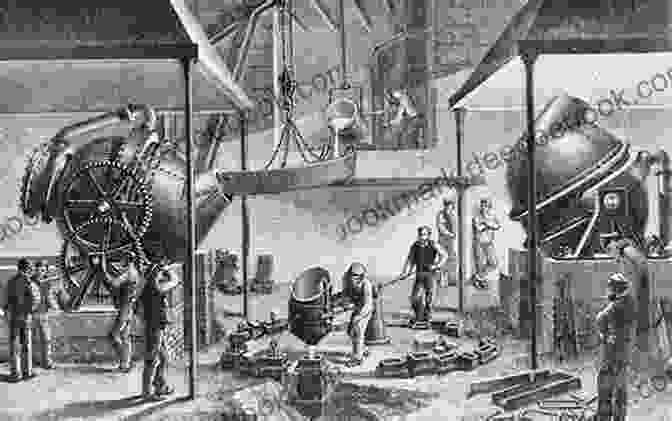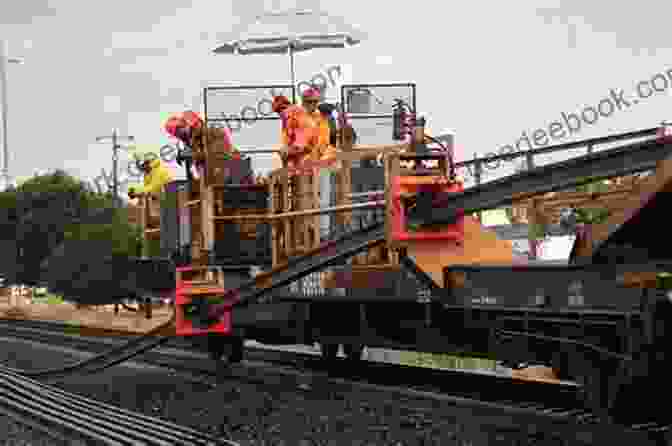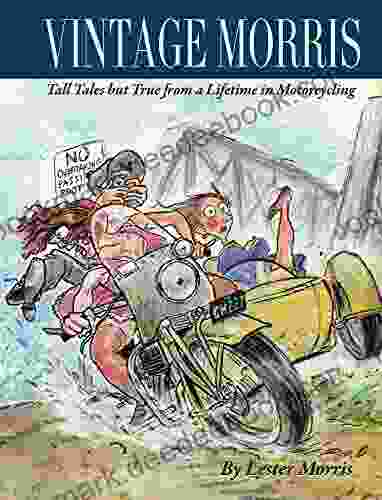The Iron Road: A Comprehensive History of the British Railway Track Since 1804

The railway track, an intricate network of steel rails that crisscrosses the British landscape, is a testament to human ingenuity and engineering prowess. Its history, spanning over two centuries, is intertwined with the Industrial Revolution, the growth of cities, and the shaping of the nation's identity.
The Early Days: Cast Iron Rails and Horse-Drawn Carriages
The origins of the British railway track can be traced back to the early 19th century, when horse-drawn carriages began running on wooden rails. These early railways, known as tramways or plateways, were primarily used for transporting coal and other heavy goods. In 1804, the world's first steam-powered railway opened in Wales, using cast iron rails. These rails were prone to cracking and breakage, but they laid the foundation for the development of a more efficient and reliable track system.
4.7 out of 5
| Language | : | English |
| File size | : | 46209 KB |
| Text-to-Speech | : | Enabled |
| Screen Reader | : | Supported |
| Enhanced typesetting | : | Enabled |
| Print length | : | 1434 pages |
| Lending | : | Enabled |
The Rise of the Steam Locomotive and Wrought Iron Rails
The invention of the steam locomotive by George Stephenson in 1814 revolutionized railway transportation. These powerful engines required a more robust track system, leading to the adoption of wrought iron rails. Wrought iron, produced by hammering and rolling molten iron, was stronger and more durable than cast iron, allowing for heavier trains and higher speeds. In 1825, the Stockton and Darlington Railway became the first public railway to use wrought iron rails, ushering in a new era of railway development.
The Era of Iron Mastery: Bessemer and Siemens Steel
The mid-19th century saw a significant breakthrough in railway track technology with the of steel. Henry Bessemer's pioneering process for producing steel from molten iron revolutionized the industry, making it possible to manufacture steel rails that were stronger, more durable, and more cost-effective than wrought iron rails. In 1867, the first Bessemer steel rail was laid on the London and North Western Railway, marking a pivotal moment in railway history.
Another significant development in steel production was the Siemens-Martin process, which improved the quality and consistency of steel. Siemens steel rails were adopted by many British railways, further enhancing the safety and efficiency of the track system.

A Bessemer steel plant in the 19th century, where molten iron was converted into steel.
Track Maintenance and Rail Standards
As the railway network expanded and trains became heavier and faster, the need for proper track maintenance and standardized rail specifications became paramount. In 1841, the Railway Inspectorate was established to oversee railway safety and ensure compliance with track standards. The inspectorate's regulations played a crucial role in improving the quality and reliability of the British railway track.
In 1893, the British Standards Institution (BSI) published the first British Standard for rails, known as BS 11. This standard established the dimensions, tolerances, and quality requirements for railway rails, ensuring uniformity and interoperability across the nation's railways.
Continuous Welded Rails and Concrete Sleepers
The 20th century witnessed further advancements in railway track technology. Continuous welded rails (CWR) were developed to eliminate the joints between individual rail sections, reducing track maintenance and improving ride comfort. The use of concrete sleepers, instead of wooden sleepers, provided greater stability and reduced track deformation.
In the 1960s, the of high-speed rail lines, such as the Advanced Passenger Train (APT),necessitated even more advanced track systems. These lines employed sophisticated track components, such as flexible sleepers, ballastless track, and tilting trains, to achieve speeds of up to 250 miles per hour (400 kilometers per hour).

Continuous welded rails on the East Coast Main Line, providing a smooth and seamless ride.
Modern Innovations and Future Prospects
The 21st century has brought about a renewed focus on sustainability and technological advancements in railway track technology. Composite sleepers, made from recycled materials such as plastic and rubber, offer increased durability and reduced environmental impact. Advanced monitoring systems, using sensors and data analytics, allow for real-time track condition monitoring and predictive maintenance.
Research is ongoing to develop even more efficient and resilient track systems. Magnetic levitation (maglev) trains, which levitate above the track using magnetic fields, offer the potential for ultra-high-speed rail travel. Maglev track systems are being developed and tested, promising to revolutionize long-distance rail transportation.
The British railway track has played a pivotal role in shaping the nation's industrial, social, and economic landscape. From the humble beginnings of horse-drawn carriages on wooden rails to the high-speed bullet trains of today, the railway track has undergone a remarkable transformation.
The evolution of the British railway track is a testament to the ingenuity and perseverance of engineers, scientists, and industry leaders. The track has not only connected cities and transported goods but has also driven technological advancements and fostered economic growth. As the railway industry continues to embrace innovation and sustainability, the British railway track will undoubtedly remain a vital part of the nation's infrastructure for generations to come.
4.7 out of 5
| Language | : | English |
| File size | : | 46209 KB |
| Text-to-Speech | : | Enabled |
| Screen Reader | : | Supported |
| Enhanced typesetting | : | Enabled |
| Print length | : | 1434 pages |
| Lending | : | Enabled |
Do you want to contribute by writing guest posts on this blog?
Please contact us and send us a resume of previous articles that you have written.
 Novel
Novel Page
Page Chapter
Chapter Reader
Reader Library
Library Paperback
Paperback E-book
E-book Paragraph
Paragraph Bookmark
Bookmark Glossary
Glossary Preface
Preface Footnote
Footnote Manuscript
Manuscript Scroll
Scroll Codex
Codex Classics
Classics Library card
Library card Narrative
Narrative Biography
Biography Autobiography
Autobiography Reference
Reference Dictionary
Dictionary Narrator
Narrator Character
Character Librarian
Librarian Catalog
Catalog Card Catalog
Card Catalog Borrowing
Borrowing Stacks
Stacks Study
Study Lending
Lending Reserve
Reserve Journals
Journals Reading Room
Reading Room Rare Books
Rare Books Thesis
Thesis Storytelling
Storytelling Awards
Awards Reading List
Reading List Theory
Theory Gunter Schubert
Gunter Schubert Heather Bean
Heather Bean Bob Marley
Bob Marley Brit W Anders
Brit W Anders Kindle Edition
Kindle Edition Sylvia Ellis
Sylvia Ellis Maggie Righetti
Maggie Righetti Marlene Laruelle
Marlene Laruelle Samy Appadurai
Samy Appadurai Michael Smith
Michael Smith Mark Elvy
Mark Elvy Pornput Suriyamongkol
Pornput Suriyamongkol Elgiva Nicholls
Elgiva Nicholls William K Kershner
William K Kershner Mint Rabbit
Mint Rabbit Mark Gillespie
Mark Gillespie Annie Tullis
Annie Tullis De Wet Potgieter
De Wet Potgieter Anthony Pell
Anthony Pell Jkbc Parthiban
Jkbc Parthiban
Light bulbAdvertise smarter! Our strategic ad space ensures maximum exposure. Reserve your spot today!

 Samuel BeckettRaised By Killer: An Unforgettable Journey Into Extreme Horror for Ages 17...
Samuel BeckettRaised By Killer: An Unforgettable Journey Into Extreme Horror for Ages 17... Isaac AsimovFollow ·19.9k
Isaac AsimovFollow ·19.9k Yukio MishimaFollow ·19.6k
Yukio MishimaFollow ·19.6k Arthur MasonFollow ·5.4k
Arthur MasonFollow ·5.4k Finn CoxFollow ·3.9k
Finn CoxFollow ·3.9k Kazuo IshiguroFollow ·16.2k
Kazuo IshiguroFollow ·16.2k Jaden CoxFollow ·19.1k
Jaden CoxFollow ·19.1k Terence NelsonFollow ·12k
Terence NelsonFollow ·12k Ian McEwanFollow ·6.8k
Ian McEwanFollow ·6.8k

 Oscar Wilde
Oscar WildeDon't Stop Thinking About the Music: Exploring the Power...
Music is an...

 Floyd Richardson
Floyd RichardsonSnowman Story Problems Math With Santa And Friends
It's a cold winter day, and...

 W. Somerset Maugham
W. Somerset MaughamWhat Every Classroom Teacher Needs To Know: A...
Teaching is a challenging...

 Edgar Cox
Edgar CoxTall Tales But True: A Lifetime of Motorcycling...
I've been riding motorcycles for over 50...

 Chinua Achebe
Chinua AchebeBuni: Happiness Is a State of Mind
Buni is a beautiful...

 Herman Melville
Herman MelvilleThe Arts and Crafts of Older Spain: Embodying the Essence...
In the heart of the Iberian...
4.7 out of 5
| Language | : | English |
| File size | : | 46209 KB |
| Text-to-Speech | : | Enabled |
| Screen Reader | : | Supported |
| Enhanced typesetting | : | Enabled |
| Print length | : | 1434 pages |
| Lending | : | Enabled |










